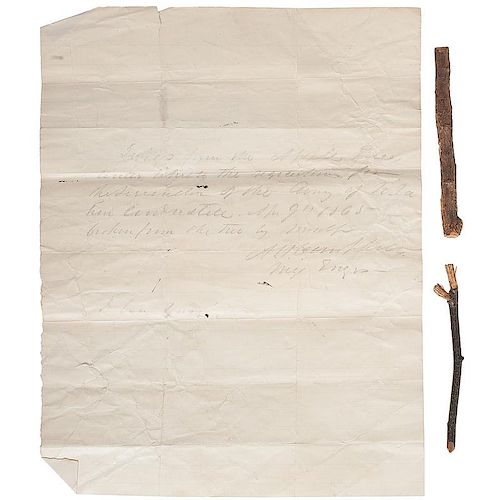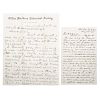Appomattox Court House Relic Acquired by Albert H. Campbell, Twigs from the Apple Tree Under Which Lee Sat Before Surrenderin
About Seller
6270 Este Ave.
Cincinnati , OH 45232
United States
With offices in Cincinnati, Cleveland and Denver, Cowan’s holds over 40 auctions each year, with annual sales exceeding $16M. We reach buyers around the globe, and take pride in our reputation for integrity, customer service and great results. A full-service house, Cowan’s Auctions specializes in Am...Read more
Two ways to bid:
- Leave a max absentee bid and the platform will bid on your behalf up to your maximum bid during the live auction.
- Bid live during the auction and your bids will be submitted real-time to the auctioneer.
Bid Increments
| Price | Bid Increment |
|---|---|
| $0 | $25 |
| $500 | $50 |
| $1,000 | $100 |
| $2,000 | $250 |
| $5,000 | $500 |
| $10,000 | $1,000 |
| $20,000 | $2,500 |
| $50,000 | $5,000 |
| $100,000 | $10,000 |
About Auction
Nov 17, 2017 - Nov 18, 2017
Cowan's Auctions dawnie@cowans.com
- Lot Description
Two letters and a twig (in two parts).
First letter is a draft of one from Campbell to General G.W. Custis Lee, January 25, 1875. In this he gives the circumstances about the historic apple tree near the McLean house at Appomattox. Campbell notes that a book by Rev. J. William Jones assumed that the only historic interest in the apple tree was that the surrender was signed under it. We know it was signed in the parlor of the McLean house. Campbell describes the day which he spent with General Lee, and notes that it was warm, so they used fence rails to make a place to sit in the shade of the tree. Campbell states that Lee "...sat on some rails... from, I should think 9 am or so to nearly sundown receiving several visits from his own & Federal officers in the meantimes....I have a most vivid recollections of that day's scene around that "historic" apple-tree and I should be very loathe to have it passed into fiction, for I perhaps was one of the very first to cut a small 'memorial' twig from its branches which I still possess and cherish dearly & I think I am correct in the main as to the time during which Gen'l. Lee remained under that tree."
The second letter is from J. William Jones, on Office Southern Historical Society letterhead, with cover, dated January 29, 1875. Jones tells Campbell that he has spoken with General Custis Lee and thanks him for the information. He notes that his point in the apple tree story was that it was not the location of the signing of the surrender, not that Lee was not there.
The twig is accompanied by the penciled note in which Campbell wrapped it, although the note is fairly worn. Nevertheless, Campbell's written and signed note attests to the twig's provenance. At some point the twig was moved to a box, and when that broke down, it (box and all) was placed in a larger box, where it now resides. Each twig measures approx. 3.75 in. long.
Confederate Map Maker Albert Henry Campbell Collection
Lots 32-35
Albert Henry Campbell (1826 – 1899) was born in Charleston, WV where he lived until he entered Brown University, Providence, RI in 1844. In Providence, he also met and married Mary Paine Stebbins in 1847. He studied civil engineering and was engaged in surveys for a number of railroads west. In 1857 he was appointed General Superintendent in charge of constructing wagon roads from Fort Kearny to the South Pass of the Rocky Mountains to the Eastern portion of California, and the road from Ft. Ridgely in Minnesota to South Pass.
Campbell produced (among many other items) the wood engravings in the 32nd and 35th Parallel volumes (New Mexico and California) of the Pacific Railroad Reports. In his capacity as superintendent, he was supervisor to Frederick Lander when Lander mounted his expedition to capture the West in art. And while Campbell was an amateur artist in his own right, he did not accompany Lander on this expedition, but his brother, James, would go as a guide.
When the Civil War erupted, Campbell cast his lot with the Confederacy. He secured an appointment as Lieutenant in the Corps of Engineers, and was later promoted to Captain, then Major. He eventually would head the Topographical Department of the Army of Northern Virginia, and spent many hours with General R.E. Lee (who was himself a more than adequate topographer), becoming a personal friend of the General. He was with Lee the entire day during which he surrendered the ANV at Appomattox Court House, and broke the first twig from the legendary apple tree (See Lot 35) under which Lee rested before the signing of the surrender.
During the war, Campbell was initially appointed Clerk in the CSA Post Office on May 15, 1861. In June 1862 he was promoted to Captain of Engineers and appointed Chief of the Topographic Department. In September 1862 Campbell was appointed assistant to Lt. Colonel W.H. Stevens, Corps of Engineers, CSA and promoted to Major a month later.
After the war, with a bit of hesitation (this was "enemy" territory now), he returned to Providence, RI and took up newspaper work for a short time. His father had founded the first newspaper in the Kanawha Valley, so it was not an unfamiliar endeavor. He then returned to Charleston and became an assistant engineer in surveying a number of rail lines, and was eventually promoted to Chief Engineer. He headed the surveys for the Potomac and Ohio line and the Baltimore, Cincinnati & Western Railroad, plus many other lines. He died at home in 1899.Provenance: Descended in the Family of Confederate Mapmaker Albert Campbell
Letters with folds as expectedCondition
Eliminate the Hassle of Third-Party Shippers: Let Cowan's Ship Directly To You!
If you'd like a shipping estimate before the auction, contact Cowan's in-house shipping department at shipping@cowans.com or 513.871.1670 x219. - Shipping Info
-
Eliminate the Hassle of Third-Party Shippers: Let Cowan's Ship Directly To You!
If you'd like a shipping estimate before the auction, contact Cowan's in-house shipping department at shipping@cowans.com or 513.871.1670 x219.
At the request of the buyer, Cowan's will authorize the shipment of purchased items. Shipments usually occur within two weeks after payment has been received. Shipment is generally made via UPS Ground service. Unless buyer gives special instructions, the shipping method shall be at the sole discretion of Cowan's Auctions, Inc.. Cowan's is in no way responsible for the acts or omissions of independent handlers, packers or shippers of purchased items or for any loss, damage or delay from the packing or shipping of any property.
-
- Buyer's Premium



 EUR
EUR CAD
CAD AUD
AUD GBP
GBP MXN
MXN HKD
HKD CNY
CNY MYR
MYR SEK
SEK SGD
SGD CHF
CHF THB
THB












